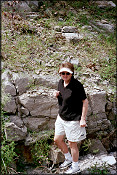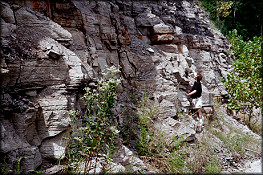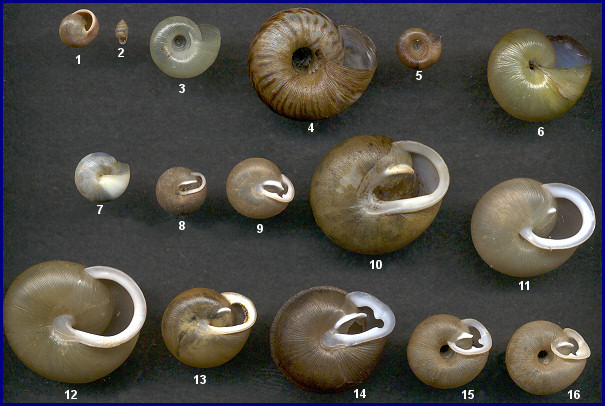|
The Reluctant Explorer |
|
By Lori Schroeder |
|
“I know that,” he replied, “But what kind is it,” he asked? My puny response: “I don't know.” From that brief exchange I knew my interest in conchology would begin a new chapter.
The rest of the summer of 2002 I spent my free time focusing my attention on new acquisitions from the Conchologists of America annual convention. It wasn't until my friend showed me the land snail in the spring of 2003 that I reflected on my conversation with Dr. Lee. So, not to be out-collected by a friend, I set out one gorgeous spring day to collect land snails. The decision of where to begin this field study was easy enough. Gil and his neighbor Don have close to seventy-five acres of property in the southern portion of Nelson County, most of the seventy five acres being mature woodlands. Luckily for me, the two gentlemen were like putty in my hands and permission for unlimited trespassing was accorded with little effort on my part. The best way for me to describe this remote area is to have you imagine what the frontiersman Daniel Boone may have encountered in his travels. Other than a tiny rustic cabin and a gravel road leading to it, the terrain is rugged and the foliage dense, more about which later. Before attempting my first foray into the field, I had to decide what tools and supplies would be required. If you want to be a scientist you must look like a scientist, act like a scientist, and order assistants to complete the menial tasks. Well, I did attempt the first two. The last would be impossible since I would be going into the field solo. I assembled supplies I thought necessary: water, bug spray, G.P.S., paper, pencil, alcohol, baggies, and garden claw. After perusing the supplies amassed in the back of my car, and not wanting to be burdened with a backpack while hiking, I settled for baggies and a garden claw for my essential gear. Oh yes, I had a walking stick too, a gift from Gil, but had to leave it behind after the first day; once it was immersed in water the walking stick soon became an unwieldy handicap. What Gil did not realize was he had unknowingly used Slippery Elm. At this point I have to pause my story to convey two deeply troubling concerns. First and foremost is I HATE spiders! Second, I am highly sensitive to poison ivy. One look at the surroundings and I could see it was going to be impossible to avoid either. With the impenetrable wall of green and spider webs evident on the horizon, serious doubts began to assail me. My initial excursions were slow going. I traipsed around a small, spring-fed pond with some exposed rock, walked the gently flowing creek, but mostly acclimated myself to the area. My garden claw became indispensable. It was used to beat back attacking spiders, dig up leaves and forest detritus, turn over rocks, but mostly to protect my hands from gross, disgusting bugs. Believe me, you do not want to see the horrors that lie beneath the surface. Any attempts to avoid the dreaded poison ivy proved impossible. I swear I didn't go out and roll in the stuff but, my gosh! it had to have jumped on me. I have surmised that when “P.I.” leaves are billowing in the wind it has to be an adapted form of communication. Like an animal can smell fear... so can the poison ivy sense an allergy. A precious bottle of Benadryl liquid became as much a part of my person as another would carry a cell phone. Conventional wisdom dictates one should not scratch the rash of Rhus contact dermatitis. I seriously doubt this was uttered by someone who has ever had said rash. |
|
I found a few shelly remnants strewn about the first couple of trips. Nothing much to show for my efforts, but it did prove snails were out there, and I became bound and determined to find them. Slowly I developed a spider stance, nothing similar to the “Sanibel Stoop,” mind you. I'll call mine the “Tarantella twist.” It involves a stick or other implement of choice. While carefully stepping into the forest I simply begin waving my arms about madly, removing spider webs from my path, (Always remember to look up! A lesson I learned the hard way), and contorting my body to avoid the dreaded web in the face. Not only must I worry with what's above me, but as a prudent hiker, I take great care to watch my footing as well. Needless to say, another lesson learned the hard way. Once I established this modus operandi, I could explore in a more harmonious manner. It must be obvious to you, the reader, that I have taken some license with my narrative. I wouldn't be here writing this account if hairy, menacing spiders and poison ivy got the better of me. In all seriousness, I did attempt to keep some semblance of scientific data and record keeping. I was eventually quite adept at finding land snails, whether from actual skill or abundance of material remains to be settled later. The environments I found conducive to snail collecting are as follows: at the base of trees, under rocks and leaves, crawling around on rocky outcroppings, along the creek above the high water mark, under dead, rotting logs. My exciting and extremely satisfying finds more than met all my expectations and certainly made up for the angst caused by poison ivy and all the gross, disgusting spiders and bugs. |
 How does one make a connection
between Florida and land snails of Kentucky? Let me start with a conundrum
presented by a friend. While hiking the woods of his Nelson County
Kentucky farm, Gil, a family friend, brought me something I would find of
great interest. Since it had a shell he assumed I would know what it was.
When presented with the shell I simply said “It's a land snail.”
How does one make a connection
between Florida and land snails of Kentucky? Let me start with a conundrum
presented by a friend. While hiking the woods of his Nelson County
Kentucky farm, Gil, a family friend, brought me something I would find of
great interest. Since it had a shell he assumed I would know what it was.
When presented with the shell I simply said “It's a land snail.”  Now for the Florida connection. Let
me take a moment and back up to the summer of 2002. My husband and I
attended the Jacksonville Shell Show as the guests of Charlotte Lloyd and
Frank Thorpe. The bargain table looked interesting and I was eager to find
a hidden treasure someone had mistakenly overlooked. My hidden treasure
was coming all right, but not in the form I thought.
While continuing my search I heard a very vocal personage addressing me
from across the room. When I turned to see who was bellowing my name, lo
and behold, it was the incomparable Dr. Lee. Within minutes our congenial
conversation became a tutorial in the molluscan fauna of Kentucky.
Now for the Florida connection. Let
me take a moment and back up to the summer of 2002. My husband and I
attended the Jacksonville Shell Show as the guests of Charlotte Lloyd and
Frank Thorpe. The bargain table looked interesting and I was eager to find
a hidden treasure someone had mistakenly overlooked. My hidden treasure
was coming all right, but not in the form I thought.
While continuing my search I heard a very vocal personage addressing me
from across the room. When I turned to see who was bellowing my name, lo
and behold, it was the incomparable Dr. Lee. Within minutes our congenial
conversation became a tutorial in the molluscan fauna of Kentucky.